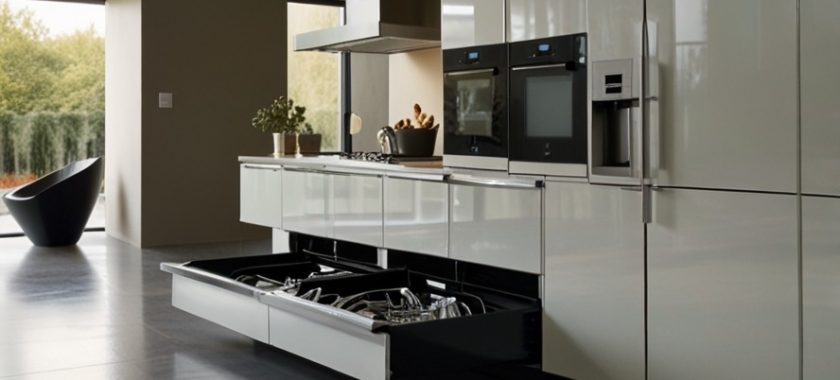The kitchen is the heart of the home, and its design can significantly impact both the functionality and safety of this essential space. One critical aspect of kitchen design is the placement of the oven. Proper oven positioning not only enhances cooking efficiency but also ensures safety for all kitchen users. In this article, we will explore the best practices for positioning your oven to maximize both safety and efficiency in your kitchen.
Importance of Oven Placement
The oven is a vital appliance in any kitchen, used for baking, roasting, and a variety of other cooking methods. Its location within the kitchen can influence several factors, including workflow, accessibility, and safety. Poor placement can lead to accidents, inefficiencies, and frustration during meal preparation. By strategically positioning the oven, you can create a more functional and safer kitchen environment.
Key Factors to Consider
⠀
When determining the optimal position for your oven, several factors should be taken into account:
⠀
- Workflow and Kitchen Triangle
⠀
The concept of the kitchen triangle—comprising the sink, refrigerator, and stove/oven—has long been a fundamental principle in kitchen design. This layout minimizes the distance between these critical points, facilitating smooth movement and efficient cooking.
⠀
Optimal Positioning: Place the oven within this triangle, preferably adjacent to the stove, so that transferring items between the stove and oven is convenient and safe. This setup allows for easy monitoring of cooking activities and reduces the risk of spills or accidents.
⠀
- Height and Accessibility
⠀
The height at which the oven is installed plays a crucial role in safety and usability. Ovens positioned too high or too low can cause strain and increase the risk of accidents, especially when handling hot and heavy dishes.
⠀
Optimal Positioning: Wall ovens or built-in ovens should be installed at eye level, making it easier to check on food without bending or reaching up. This height is particularly beneficial for individuals with mobility issues or those who use the kitchen frequently. For freestanding or range ovens, ensure there is adequate space for safe access and that they are not placed directly on the floor.
⠀
- Proximity to Other Appliances
⠀
The oven should be positioned with consideration for its relationship to other appliances. Placing the oven too close to the refrigerator can affect the refrigerator’s efficiency, as the heat from the oven forces the refrigerator to work harder to maintain its temperature. Similarly, placing it near a dishwasher can create congestion and disrupt the workflow.
⠀
Optimal Positioning: Maintain a sufficient distance between the oven and heat-sensitive appliances like the refrigerator. Ideally, there should be a countertop or a work area between them to act as a buffer zone. This arrangement allows for smooth transitions between cooking and cooling tasks.
- Ventilation and Safety Clearances
⠀
Proper ventilation is essential to prevent the buildup of heat and cooking fumes. Ovens generate significant heat, and adequate clearance around the appliance is necessary to ensure safety and efficiency.
⠀
Optimal Positioning: Ensure there is ample space around the oven for air circulation. This is particularly important for built-in ovens, which require clearances specified by the manufacturer. Installing the oven near a window or a range hood can enhance ventilation and help dissipate heat and odors.
⠀
- Counter Space and Work Zones
⠀
Adequate counter space near the oven is crucial for preparing and staging food. It provides a convenient area to place hot dishes as they come out of the oven and supports the overall cooking process.
⠀
Optimal Positioning: Install the oven adjacent to or near a substantial stretch of countertop. This space can serve as a prep area, making it easy to transfer food from the counter to the oven and vice versa. Avoid placing the oven at the end of a countertop or in a corner where counter space is limited.
⠀
- Safety Considerations
⠀
Safety is paramount in the kitchen, especially when dealing with high-temperature appliances like ovens. The placement of the oven should minimize the risk of burns, accidental contact, and potential hazards.
⠀
Optimal Positioning: Avoid placing the oven in high-traffic areas or near doorways where people might accidentally bump into it. It should also be positioned away from the reach of children to prevent accidental burns. If possible, choose a location that allows for clear visibility of the oven’s controls and cooking progress.
⠀
Additional Tips for Optimal Oven Placement
⠀
– Lighting: Ensure the oven is placed in a well-lit area to enhance visibility and safety during use.
– Power Supply: Position the oven near appropriate power sources to avoid the need for long and potentially hazardous electrical connections.
– Future Proofing: Consider the potential need for future modifications or appliance upgrades. Choose a location that offers some flexibility for changes in kitchen layout or appliance replacements.
⠀
Proper oven placement requires careful planning and expert installation. At Chula Vista Appliance Repair Company, we specialize in ensuring your kitchen appliances are installed for maximum efficiency and safety. Our team of experienced technicians can help you find the optimal position for your oven, taking into account all the key factors discussed.
⠀
Whether you’re renovating your kitchen or installing a new oven, trust Chula Vista Appliance Repair Company for professional, reliable service. Contact us today to schedule a consultation and let us help you create a kitchen that’s both safe and functional.
Contact us
(619) 880-5508


